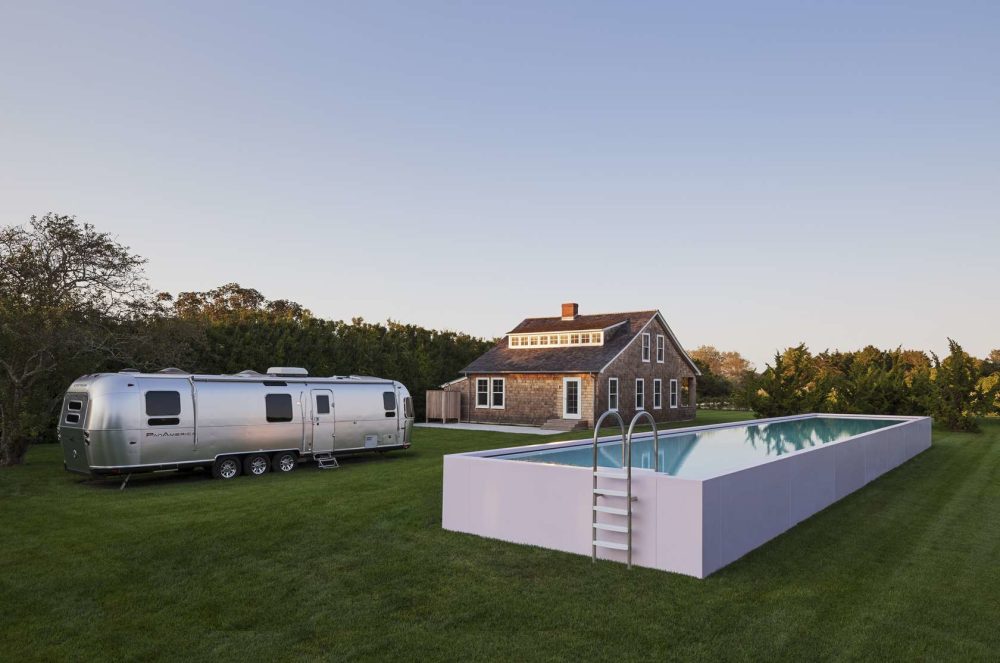
Generally speaking, the varied shades of pink are often discounted as too girlish, juvenile or campy for any significant treatment in architecture. Because of these associations, more often than not, the color is reserved for decorative effect or other, more trivial applications. Think 80s kitsch-pastiche, Googie-style roadside architecture, or the household princess playhouse.
Notwithstanding the blithe and often gendered attributes, pink is being unilaterally approached. Coinciding with societal movements toward gender equality and fluidity, the color is being used as a form of open-ended expression, where different approaches to color usage are thanks to open exchange in the digi-sphere. Moving away from secondary use as it relates to gender, youth and playfulness, architecture and other areas of design are embracing the warm shade. In fact, Pantone presented ‘rose quartz’ as one of two colors of the year that represent a symbolic expression of mood and attitude. As it were, pink is now common place.
Below you’ll find a few projects that make the most of the flushed hue, which for some reason, are somehow ordinary and extraordinary all at once.
Fire Station Vierschach by Pedevilla Architects, Innichen, Italy
This light weight concrete fire station was intentionally made a red color to indicate the function of the building. On the interior, stone pine and native Loden wood create a warm contrast to the concrete exterior, providing a cohesive and inviting atmosphere.
Surf Shack by Roger Ferris + Partners, Southampton, N.Y., United States
Only 200 yards from the ocean, this shingled cottage is outfitted with a Pan-Am style motor vehicle and an above-ground 10 foot by 75 foot pink pool clad in Corian. Located in a wealthy Long Island area, the project is a tribute to the ordinary vernacular and 1950s pop culture.
Sustainable Housing Model by Tatiana Bilbao SC, Mexico
Using concrete blocks and wooden pallets for a sustainable housing prototype, this project developed as a flexible family dwelling that can be constructed for under $8,000. This pink scheme installed in Mexico demonstrates the modular capability of the project, which allows homes to be expanded in phases to adapt to each family’s individual budget and requirements.
92-bed Nursing Home in Pont-sur-Yonne by Dominique Coulon & Associés, Pont-sur-Yonne, France
This nursing home is enveloped around a vibrant pink interior courtyard, housing 96 rooms complete with touches of warm pink and solar orientation. Inside, the traffic routes are flooded with sunlight, ideal for strolling through warm hued ergonomically designed seating areas.
Spring Forest by Draisci Studio, London, United Kingdom
Designed as an installation for Clerkenwell Design Week, 100 pink and red umbrellas cover a large urban space like a forest of giant poppy flowers. Offering an intimately shaded place of rest, sunlight filters through an unusual canopy with red foam-clad scaffolding.
House Taishido by Akira Koyama + KEY OPERATION INC. / ARCHITECTS, Taishido, Japan
This family residence is outfitted with a bright pink garage that is offset by the gray stucco facade. With a complex interior consisting of rooms of varying sizes, small openings and steps were designed for the family cat to have free mobility beneath the house’s asymmetrical roofline.
Turning Pink by LEONG LEONG, Manhattan, N.Y., United States
Located in New York’s Chinatown, this giant pink fortress was made from three-inch rigid insulation and mirrored acrylic. As part of a temporary and site-specific installation that was part of a series, the pink installation explores “the translation of a legible figure into a continuous visual field.”
CANOPIES WORLDS THINNEST STEEL ROOF by Maxwan Architects + Urbanists, Rotterdam, Netherlands
Paying close attention to public space surrounding railway hubs, “hammock and pillow” canopy structures were implemented as a low-cost solution to create attractive and functional environments. Despite weighing five tons each, the razor-thin rooftops appear weightless, bent in the form of a wind-blown suspended cloth.
